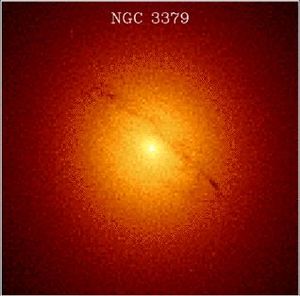- Messier 105
-
Messier 105 
M105, as viewed by the HST;
Credit: NASA/ESAObservation data (J2000 epoch) Constellation Leo Right ascension 10h 47m 49.6s[1] Declination +12° 34′ 54″[1] Redshift 911 ± 2 km/s[1] Distance 32.0 ± 1.6 Mly (9.8 ± 0.5 Mpc)[2] Type E1[1] Apparent dimensions (V) 5′.4 × 4′.8[1] Apparent magnitude (V) 10.2[1] Other designations NGC 3379,[1] UGC 5902,[1] PGC 32256[1] See also: Galaxy, List of galaxies Messier 105 (also known as M105 and NGC 3379) is an elliptical galaxy in the constellation Leo. Messier 105 is known to have a supermassive black hole.
Contents
History
Messier 105 was discovered by Pierre Méchain on 24 March 1781, just a few days after he discovered the nearby galaxies Messier 95 and Messier 96.[3] This galaxy is one of several that were not originally included in the original Messier Catalogue compiled by Charles Messier. Messier 105 was included in the catalog only when Helen S. Hogg found a letter by Méchain describing Messier 105 and when the object described by Méchain was identified as a galaxy previously named NGC 3379.[3]
Galaxy group information
Messier 105 is one of several galaxies within the M96 Group, a group of galaxies in the constellation Leo. The group also includes the Messier objects M95 and M96.[4][5][6][7]
References
- ^ a b c d e f g h i "NASA/IPAC Extragalactic Database". Results for M105. http://nedwww.ipac.caltech.edu/. Retrieved 2006-11-16.
- ^ Jensen, Joseph B.; Tonry, John L.; Barris, Brian J.; Thompson, Rodger I.; Liu, Michael C.; Rieke, Marcia J.; Ajhar, Edward A.; Blakeslee, John P. (2003). "Measuring Distances and Probing the Unresolved Stellar Populations of Galaxies Using Infrared Surface Brightness Fluctuations". Astrophysical Journal 583 (2): 712–726. arXiv:astro-ph/0210129. Bibcode 2003ApJ...583..712J. doi:10.1086/345430.
- ^ a b K. G. Jones (1991). Messier's Nebulae and Star Clusters (2nd ed.). Cambridge University Press. ISBN 0-521-37079-5.
- ^ R. B. Tully (1988). Nearby Galaxies Catalog. Cambridge University Press. ISBN 0-521-35299-1.
- ^ P. Fouque, E. Gourgoulhon, P. Chamaraux, G. Paturel (1992). "Groups of galaxies within 80 Mpc. II - The catalogue of groups and group members". Astronomy and Astrophysics Supplement 93: 211–233. Bibcode 1992A&AS...93..211F.
- ^ A. Garcia (1993). "General study of group membership. II - Determination of nearby groups". Astronomy and Astrophysics Supplement 100: 47–90. Bibcode 1993A&AS..100...47G.
- ^ G. Giuricin, C. Marinoni, L. Ceriani, A. Pisani (2000). "Nearby Optical Galaxies: Selection of the Sample and Identification of Groups". Astrophysical Journal 543 (1): 178–194. arXiv:astro-ph/0001140. Bibcode 2000ApJ...543..178G. doi:10.1086/317070.
External links
- StarDate: M105 Fact Sheet
- SEDS: Elliptical Galaxy M105
- Messier 105 on WikiSky: DSS2, SDSS, GALEX, IRAS, Hydrogen α, X-Ray, Astrophoto, Sky Map, Articles and images
- ESA/Hubble image of M105
Coordinates:
 10h 47m 49.6s, +12° 34′ 54″
10h 47m 49.6s, +12° 34′ 54″Messier objects List M1 · M2 · M3 · M4 · M5 · M6 · M7 · M8 · M9 · M10 · M11 · M12 · M13 · M14 · M15 · M16 · M17 · M18 · M19 · M20 · M21 · M22 · M23 · M24 · M25 · M26 · M27 · M28 · M29 · M30 · M31 · M32 · M33 · M34 · M35 · M36 · M37 · M38 · M39 · M40 · M41 · M42 · M43 · M44 · M45 · M46 · M47 · M48 · M49 · M50 · M51 · M52 · M53 · M54 · M55 · M56 · M57 · M58 · M59 · M60 · M61 · M62 · M63 · M64 · M65 · M66 · M67 · M68 · M69 · M70 · M71 · M72 · M73 · M74 · M75 · M76 · M77 · M78 · M79 · M80 · M81 · M82 · M83 · M84 · M85 · M86 · M87 · M88 · M89 · M90 · M91 · M92 · M93 · M94 · M95 · M96 · M97 · M98 · M99 · M100 · M101 · M102 · M103 · M104 · M105 · M106 · M107 · M108 · M109 · M110See also  Book:Messier objects ·
Book:Messier objects ·  Category:Messier objects
Category:Messier objects  Portal:AstronomyCategories:
Portal:AstronomyCategories:- Elliptical galaxies
- M96 Group
- Leo constellation
- Messier objects
- NGC objects
- UGC objects
- PGC objects
Wikimedia Foundation. 2010.
